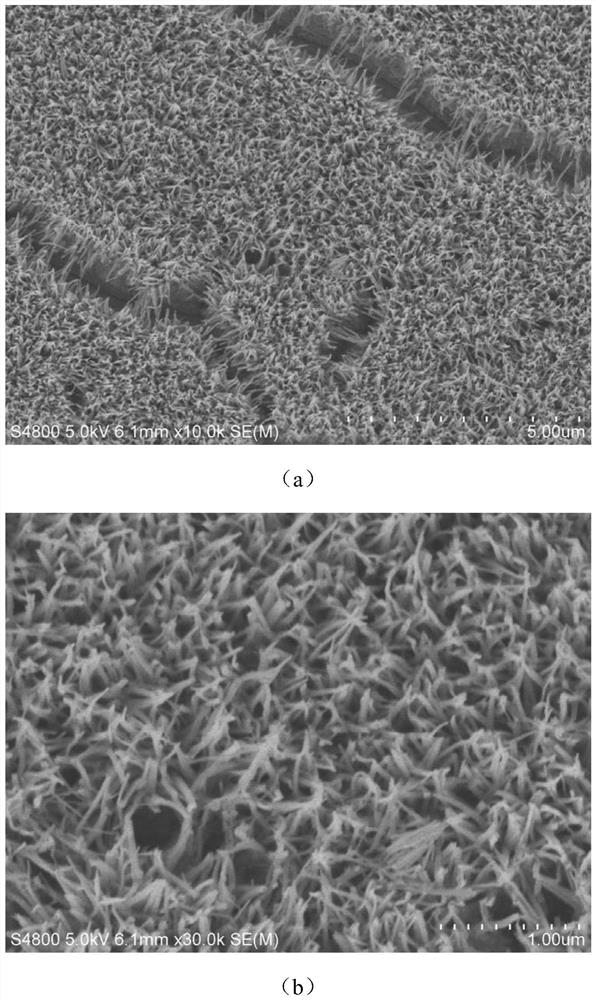A kind of photocatalytic thin film based on titanium nitride and titanium oxide and preparation method thereof
A photocatalytic thin film, titanium oxide technology, applied in chemical instruments and methods, catalyst activation/preparation, physical/chemical process catalysts, etc., can solve the problems of low production efficiency, complex equipment, unfavorable industrial application, etc., and achieve the improvement effect. , narrow the forbidden band width, improve the effect of photocatalysis
- Summary
- Abstract
- Description
- Claims
- Application Information
AI Technical Summary
Problems solved by technology
Method used
Image
Examples
Embodiment 1
[0028] Step 1. Make the area 5×5cm 2 Immerse the cleaned titanium sheet in 50mL of hydrogen peroxide solution with a mass concentration of 6%, add 1mL of nitric acid with a mass fraction of 0.05% and 10mg of melamine at the same time, react at 80°C for 72 hours, take it out and dry it completely after cleaning, and dry it at 400 ℃ air atmosphere heat treatment for 3 hours, obtained on the titanium substrate growth TiO 2 Thin films of nanowire arrays;
[0029] Step 2, loading TiO on the titanium sheet 2 The samples of nanowires were heat-treated at 750°C for 3 hours in an ammonia atmosphere with a flow rate of 100mL / min to obtain TiN 0.3 / TiO 0.89 One-dimensional nanowire films;
[0030] Step 3: Add 100 mL of deionized water, 1.75 g of glycine, 0.6 mL of 63% nitric acid and 1.25 g of titanyl sulfate into the porcelain crucible. The crucible was transferred to a heat treatment furnace at 400°C for solution combustion reaction to obtain a fluffy black powder. Add 0.5g of bl...
Embodiment 2
[0034] Step 1. Make the area 5×5cm 2Immerse the cleaned titanium sheet in 50mL of hydrogen peroxide solution with a mass concentration of 30%, add 1mL of nitric acid with a mass fraction of 5% and 100mg of melamine at the same time, react at 80°C for 72 hours, take it out and dry it completely after cleaning, and dry it at 550 ℃ air atmosphere heat treatment for 3 hours, obtained on the titanium substrate growth TiO 2 Thin films of nanowire arrays;
[0035] Step 2, loading TiO on the titanium sheet 2 The samples of nanowires were heat-treated at 900°C for 3 hours in an ammonia atmosphere with a flow rate of 100mL / min to obtain TiN 0.3 / TiO 0.89 One-dimensional nanowire films;
[0036] Step 3: Add 100 mL of deionized water, 1.75 g of glycine, 0.6 mL of 63% nitric acid and 1.25 g of titanyl sulfate into the porcelain crucible. The crucible was transferred to a heat treatment furnace at 400°C for solution combustion reaction to obtain a fluffy black powder. Add 1g of black ...
Embodiment 3
[0040] Step 1. Make the area 5×5cm 2 Immerse the cleaned titanium sheet in 50mL of hydrogen peroxide solution with a mass concentration of 20%, add 1mL of nitric acid with a mass fraction of 2.5% and 100mg of melamine at the same time, react at 80°C for 72 hours, take it out and clean it, dry it completely, and dry it at 550 ℃ air atmosphere heat treatment for 3 hours, obtained on the titanium substrate growth TiO 2 Thin films of nanowire arrays;
[0041] Step 2, loading TiO on the titanium sheet 2 The samples of nanowires were heat-treated at 800°C for 2 hours in an ammonia atmosphere with a flow rate of 100mL / min to obtain TiN 0.3 / TiO 0.89 One-dimensional nanowire films;
[0042] Step 3: Add 100 mL of deionized water, 1.75 g of glycine, 0.6 mL of 63% nitric acid and 1.25 g of titanyl sulfate into the porcelain crucible. The crucible was transferred to a heat treatment furnace at 400°C for solution combustion reaction to obtain a fluffy black powder. Add 0.5g of black ...
PUM
 Login to View More
Login to View More Abstract
Description
Claims
Application Information
 Login to View More
Login to View More - R&D
- Intellectual Property
- Life Sciences
- Materials
- Tech Scout
- Unparalleled Data Quality
- Higher Quality Content
- 60% Fewer Hallucinations
Browse by: Latest US Patents, China's latest patents, Technical Efficacy Thesaurus, Application Domain, Technology Topic, Popular Technical Reports.
© 2025 PatSnap. All rights reserved.Legal|Privacy policy|Modern Slavery Act Transparency Statement|Sitemap|About US| Contact US: help@patsnap.com



